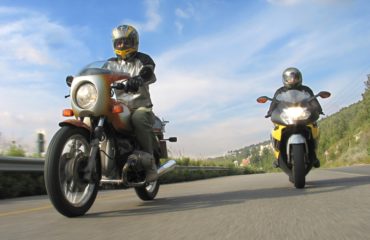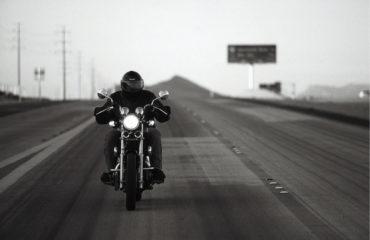Motorcycle. That one word conjures up so many images. For some people it means freedom, adventure and the open road. To others it means “biker gangs” and danger and death. There are even those who call a motorcycle an organ donor machine because of the possible devastation that can come from a motorcycle crash. This one word inspires adventure or dread, depending upon the person’s perspective.
I have mixed feelings. Growing up, I always thought I would own a motorcycle. I did ride one a few times while in high school. But as I grew older, and learned more about the dangers of riding, especially about those other drivers who pull out in front of a motorcycle, I became more hesitant. I still think about riding – but one thing I never think about is riding a motorcycle without a helmet.
The Traffic Safety Guy Becomes a Witness
In one of those strange twists of fate, last week I was out for a morning walk along the George Washington Parkway in the Washington D.C. area. It was a beautiful morning, the Potomac River was calm and there was a cool breeze coming off the water. I was enjoying the start of the day. Traffic was going by, possibly heading to DC for work, but it was in the background, a white noise so many of us learn to tune out. I had just walked past a small park when I heard a loud crash. I turned around and saw a motorcycle and its rider, separately heading towards me, the cyclist rolling over and over, the motorcycle skimming along on its side. Both stopped only a short distance from me.
I ran over to the cyclist and saw that he was conscious, but one leg was severally injured; I could see the bone sticking out of it. I put my hand on his chest and told Peter[1] to stay down, as he was trying to roll over and get up. Others in the area arrived and we all got him to stay down. While waiting for the paramedics, he answered our questions as we tried to distract him from his injuries and keep him alert. Though it seemed to take forever, the paramedics and police arrived quickly. As you might guess, since Peter was conscious and alert, he was wearing a helmet.
Once the paramedics left with Peter, and I had spoken with the police about my observations, I glanced around a bit more. What did I see? Across from the park I had walked past was a side road – and still there in the middle of the Parkway was a car that had obviously pulled out from the side road to turn left and head north. Peter was going south on the Parkway. I estimated the car was over 100 yards away from where I had reached Peter.
There is no question in my mind that the driver pulled out in front of Peter. Why? I will most likely never know that answer, but my obvious thought is that the driver wasn’t paying attention. Maybe he was on his phone, or texting, or looking in the wrong direction, or even looking across the Parkway at the Potomac River, or too deep in a daydream to really look before proceeding into the road. Whatever the reason, the driver pulled out and Peter’s life took an unexpected, and traumatic, turn.
Later that morning, another officer called to ask me a few more questions, and he shared with me the good news that Peter was doing well and going to make it.
Helmets Save Lives
May is Motorcycle Safety Month. It is a time to raise everyone’s awareness of what we can all do to keep motorcycle riders safe. In 2012, 4,957 motorcyclists were killed, with 41 percent of the motorcycle rider fatalities and 53 percent of the passenger fatalities not wearing a motorcycle helmet. In 2012, if all motorcyclists had worn helmets, an additional 781 lives could have been saved. [2]
This is not an issue only in the United States. “Head and neck injuries are the main cause of severe injury, disability and death among motorcycle users. In European countries, head injuries contribute to approximately 75% of deaths among motorcycle users; in some low- and middle-income countries, head injuries are estimated to account for up to 88% of such fatalities.”[3]
Wearing the right helmet is the first step in wearing the proper gear. Motorcyclists are well-advised to also wear sturdy material that covers the body, including gloves and heavy shoes or boots. T-shirts, shorts, and flip-flops are NOT the proper gear. Peter was wearing a helmet, and heavier material that clearly helped.
Share the Road
Road safety is about understanding the risks and then taking appropriate steps to avoid the risk—as much as possible. Riding a motorcycle is inherently risky. Riders have responsibilities, like not weaving in and out of traffic; driving at a safe speed; and not being careless when passing. But drivers also have a critical responsibility: we must stay focused on the task at hand, driving. In 2011, there were 1,998 two-vehicle fatal crashes out of the 4,612 involving a motorcycle and another type of vehicle. In 38 percent (757) of these crashes, the other vehicle was turning left while the motorcycle was going straight, passing, or overtaking another vehicle.[4]
 Motorcycles, cars, and trucks all interact together on the road, mandating that we stay alert and share the road.
Motorcycles, cars, and trucks all interact together on the road, mandating that we stay alert and share the road.
As a friend of mine stated, I will never know the pain Peter will suffer, or how long it will last. I will never know about the work he will do to recover, how long it will take, or even if he ever does completely recover. But I have no doubt that he is better today because he wore a helmet that provided some protection. It is very possible without that helmet, I would have seen another individual added to this year’s fatalities total.
Now is the time to step it up and recognize the inherent dangers, and have motorcyclist and drivers take the necessary steps to protect ourselves and others:
Motorcyclists:
- Always wear a helmet and protective gear
- Don’t drink and ride
- Drive defensively
- Don’t drive aggressively
- Have your bike’s headlight on at all times to improve your visibility to other drivers.
Drivers:
- Always buckle up
- Put the phone down and drive
- When turning left – check and then recheck before going forward
- Remember that motorcycles are on the road and actively watch for them
And above all, remember to “Share the Road.”
[1] Peter is not his real name. [2] Traffic Safety Facts, 2011, Motorcycles. NHTSA, May 2013. DOT HS 811 765 [3] Global Status Report on Road Safety, 2013. World Health Organization [4] Traffic Safety Facts, 2011, Motorcycles. NHTSA, May 2013. DOT HS 811 765








